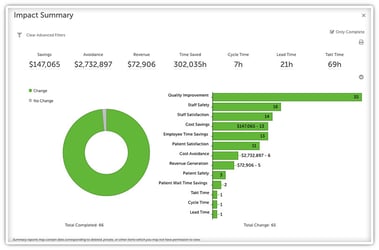 Organizations that strive for continuous improvement outpace the competition, regardless of the types of products or services they offer. From retail and manufacturing to healthcare and construction, the intensity of effort dedicated to daily positive change in an organization is directly tied to customer satisfaction and financial success.
Organizations that strive for continuous improvement outpace the competition, regardless of the types of products or services they offer. From retail and manufacturing to healthcare and construction, the intensity of effort dedicated to daily positive change in an organization is directly tied to customer satisfaction and financial success.
What’s Important Gets Measured
If you examine the metrics most commonly used to track an organization's results, you'll probably find a robust reporting framework based on financial performance in place. Profit and loss is an obvious indicator of a company's health. Customer service is another, which is why companies of all types measure and track customer satisfaction metrics. HR metrics, like turnover, are also carefully measured in most industries.
Tracking success toward these and other effectiveness measures is helpful only to the extent that you use that data to adjust and improve processes across the organization. This means that continuous improvement is a component of every metric that senior executives care about.
While many organizations track the downstream artifacts of improvement work, fewer do a great job of keeping tabs on process improvement activities and results. But we'd argue that measuring, monitoring, and reporting on improvement work is an essential thing your organization can do to ensure that you meet your strategic goals and outperform the competition. Here are five reasons why.
Things that get measured improve.
Measuring and reporting continuous improvement metrics shows the organization that this improvement work is as essential as all other things you regularly track. In addition, when people know that you're following the activities and impacts associated with improvement, an increased sense of accountability contributes to engagement. This is especially true when the metrics are visible, which is why the use of wallboards to display the current state of improvement projects is so popular and effective.
It becomes natural to align projects with strategic goals.
When improvement projects are tracked and widely shared, it is easier to determine which projects are aligned with strategic goals and which are outliers. Not every effort will directly affect a stated goal, of course, but the bulk of the work should be in the furtherance of the essential objectives. Unfortunately, this isn't easy to achieve if you don't have a consistent platform for collecting information about improvement work and a standard method of reporting engagement, activity, and impact metrics.

The discipline of measurement forces people to set smarter goals.
Many organizations are too vague when they discuss their current and future states. For example, they may worry that production costs are too high but fail to document what that means exactly. How much do costs need to come down? By when? Who is responsible? Without answers to these questions and more, success is unlikely. When you start to measure improvements of any type, it is necessary to set SMART goals. SMART goals are Specific, Measurable, Agreed upon, Realistic, and Time-based.
Everyone has the data to make better decisions.
Making solid decisions that promote the spread of continuous improvement requires data. Having a view into which areas of the organization are struggling and having a consistent, objective way to measure performance helps leaders focus their coaching resources for a higher return on improvement investments.
Understanding what types of activities result in high-impact improvements makes it easier to put more energy into efforts that are likely to succeed.
Well-documented improvement efforts earn additional resources.
Measuring the tangible impact of continuous improvement makes it possible to demonstrate for executives how the effort impacts the highly visible metrics they care most about, including profitability and growth. In addition, the ability to point to actual data regarding engagement and activity metrics will give leaders confidence that the improvement culture is indeed alive and growing.
How to Measure Process Improvement
If you find these reasons compelling and want to start to measure improvement results, the next step is to decide how to do it. Our clients have found activity, impact, and engagement metrics to be an excellent place to start.
Activity Metrics
Knowing what type of improvement is happening and how quickly is the first step in assessing your culture's health. Activity reports will show you how hard the organization is working toward positive change, who is involved in the work, and where more coaching and mentoring is needed.
In the perfect world, improvements are completed at about the same rate as new opportunities coming into the system. Projects that get bogged down after being identified lower morale, decrease engagement, and reduce bottom-line impact. Leaders should be able to find the percentage of in-progress improvements at any time.
Engagement Metrics
By tracking who is active on improvement projects over time, you can develop a baseline, compare current results to that baseline, and identify any trends. For example, you discover whether the ROI you've achieved is due to a small group of employees (a sign of a culture in need of attention), or a large group, indicating a vibrant culture.
Engagement reporting will tell you how many opportunities people submit per year on average and the number of team members active in your improvement management system. This gives you a view into how deep and wide your improvement culture goes.
Impact Metrics

The impact of improvement on the bottom line is the most obvious way to prove your return on investment. So, in addition to financial metrics such as cost savings, it's also imperative to track qualitative variables such as time savings, safety enhancements, health, performance improvement, and environmental impact.
Continuous improvement software allows you to tether improvement with impact in your reporting so that you can drill down into any metric to verify accuracy. Suppose you see a cost reduction that looks unreasonably high, for example. In that case, you can quickly see what improvements contribute to that and validate that the reporting impact on each is correct.
Implementing these process improvement measures will help you get more out of your improvement efforts. It will make it easier to argue for continued investment and help you find areas where your team could use a boost. More importantly, it will demonstrate to you, other leaders, and your team that improvement is something that can be managed and measured.




Add a Comment